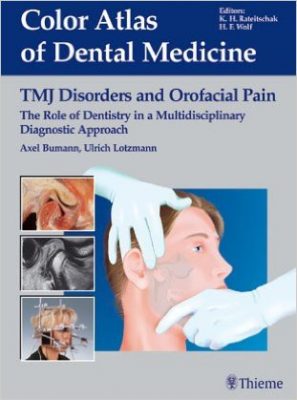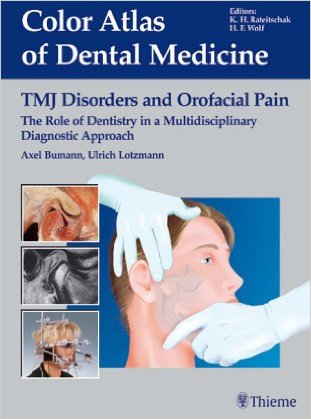 (Part of a Series on Color Atlas of Dental Medicine)
(Part of a Series on Color Atlas of Dental Medicine)
Authors: Axel Bumann, DDS and Ulrich Lotzmann, DDS, in collaboration with James Mah, DDS. Translator: Richard Jacobi, DDS.
Publisher: Thieme – 360 pages, with 1,304 illustrations
Book Review by: Nano Khilnani
Temporomandibular joint (TMJ) disorders occur as a result of issues with our jaw, jaw joints, and surrounding facial muscles that enable us to move our jaws and chew. The treatment of such disorders requires a multidisciplinary, cooperative approach involving dentists, oral and maxillofacial surgeons, and radiologists.
This large (12” x 9”) book contains more than 1,300 images. The three authors seem to have taken a “see-and-learn’ approach to educating readers – students and practitioners – on the numerous (322) topics shown and discussed in this book. This is part of the reason this is called an ‘atlas,’ and it is akin to a indispensable reference manual. Whatever this may be called, it is an important resource with a huge amount of information and an incredible average of nearly 4 images per page.
The vast amount of content in this book is organized around several groups of pages with no Part or Section titles, but with these headings:
- Introduction
- Primary Dental Evaluation
- Anatomy of the Masticatory System
- Manual Functional Analysis
- Imaging Procedures
- Mounting of Casts and Occlusal Analysis
- Instrumented Analysis of Jaw Movements
- Diagnoses and Classifications
- Principles of Treatment
- Illustration Credits
- References
- Index
Among the numerous topics covered in this book are: articular disk; Bilaminar Zone; condylar positions; development of upper and lower joint spaces; embryology of the temporomandibular joint and the muscles of mastication; findings in the teeth and mucous membranes; glenoid fossa overview of dental examination techniques; hyperplasia of the coronoid process;
Also: interocclusal registration materials; jaw relation determination for edentulous patients; lateral pterygoid muscle; manifestations of joint surface changes; neuromuscular deprogramming; overview of dental examination techniques; patient history; repositioning splint; styloid or eagle syndrome; tongue musculature; and much more.
This book serves as a vital guide that all dentists and related specialists will find useful in diagnosing and treating patients with TMJ disorders, including understanding the anatomical, physiological, and psychological aspects of what they see and read about in it.
Imaging and proper interpretation of conditions found in patients is critical to correct treatment. In most cases, TMJ disorders are viewed with magnetic resonance images (MRIs), and this book provides numerous items using this imaging modality.
A useful cross-reference section entitled Joint Disorders – Articular Surfaces (International Classification of Diseases, 9th Revision – is found on pages 284-300. It presents from left to right: Diagnosis, Deformation of the articular surfaces, Osteoarthrosis, Osteoarthrits, Bony Ankylosis, etc., and from top to bottom ICDA Number, Definition, Loading vector, Critical diagnostic signs, Instrumental diagnostic aids, Imaging diagnostic aids, Treatment direction, Impediments in Treatment direction, and Therapy.
All in all, this is an outstanding text and visual resource on TMJ joint disorders with vast, extensive coverage.
Editors:
Axel Burmann, DDS, PhD is Clinical Assistant Professor in the Department of Craniofacial Sciences and Therapy at the University of Southern California in Los Angeles, California. He is an orthodontist and oral surgeon in private practice at the MEOCLINIC, an international private clinic in Berlin, Germany
Ulrich Lotsmann, DDS, PhD is Professor and Chair of the Department of Prosthodontics at Philipps University in Marburg, Germany.
James Mah, DDS, MSc., DMSc. is Assistant Professor in the Department of Craniofacial Sciences and Therapy at the University of Southern California in Los Angeles, California.







